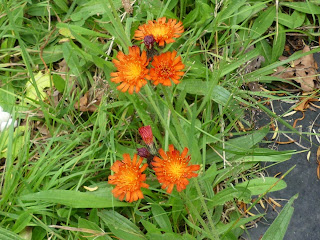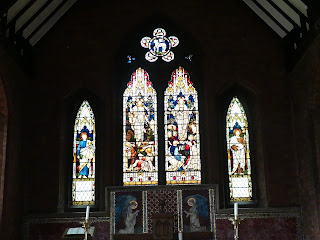Thursday, 8 August 2019
The Parish Church of St James the Great, Shirley
Last weekend family chauffeuring meant I had an hour to spare in Shirley, Solihull. Initially I was going to have a look around Hobbycraft but then I spotted a church and thought I'd look round there rather than being tempted to spend money on items I don't really need!
In the 1830's Shirley was still a relatively small hamlet but Birmingham, which had developed as an important manufacturing centre during and after the Industrial Revolution, was gradually getting closer. At this time Shirley developed a rather disreputable reputation because it was outside the Birmingham boundaries and thus the control of the authorities, Birmingham people found it was a safe place to indulge in prize-fighting, bull-baiting and cock fighting. Therefore, in 1829 the Reverend Archer Clive who had just become Rector of Solihull decided the village urgently need a Chapel of Ease to counteract the unsavoury activities.
In 1831 the Chapel was constructed on the present site and consecrated on 2nd August 1832 by the Bishop of Lichfield and Coventry. The chapel consisted of the present nave and tower and a small area at the west end for an altar. It was very unusual for the chancel to be located at the west end as it is usually placed at the east end of the church as this faces Jerusalem. The reason for this is not known - it could be that the builder misread the plan although some have suggested that it was decided to place the altar as far away as possible from The Plume of Feathers Inn just across the road which was noisy and licentious!
On 1st December 1843 the Chapel of Ease was given the status of a parish church. Improvements were made to the church in 1862 with a new roof, heating system and new organ. More alterations occurred in 1882 when unfortunately the triple decker pulpit was removed. During the 1960's and 1990's re-ordering of the interior took place.
Fox and Cubs does seem to like churchyards!
I had only planned to explore the churchyard but then I discovered the church was open. I must admit that usually I am not keen on more recent churches as it is the history of medieval churches that appeals to me but there was actually quite a lot to see in this particular church.
The 1960's chipstone font was originally on a brick plinth but a stone plinth replaced this in 1995.
Stations of the Cross - 14 carvings of the final journey of Jesus Christ. At one time pilgrims would walk along the path that Jesus followed stopping to pray at important places. I don't remember seeing such carvings in a church before - photos of just a few of them.
I would imagine most of the stained glass is Victorian?
The church is dedicated to St James - the Patron Saint of Pilgrims. The decoration on his hat in the photo below is a shell - the scallop shell is one of his symbols and it is believed that pilgrims carried scallop shells to scoop water from streams and brooks to drink as they walked. This shell became the badge of pilgrims who visited the Shrine of St James at Santiago de Compostela, Spain.
The West Window in the Chancel
Agnus Dei or Lamb of God - symbol of purity, innocence and sacrifice
St James is holding a pilgrim's staff. He was the first of Jesus's disciples to undertake a missionary journey.
"Green Man"
I thought the coloured glass in the porch was really rather lovely.
It was good to see that areas of grass in the churchyard had been left uncut and also ivy was allowed to scramble over older tombs and gravestones.
I found this gravestone interesting as my father served on HMS Indomitable in the Second World War.
All photos taken by me with the Panasonic Lumix FZ330 bridge camera
Reference: "The Parish Church of St James the Great, Shirley A History 1832-1992" by Mary Tweddle BA (Hons)
Subscribe to:
Post Comments (Atom)
































































10 comments:
Like you, I once never had any interest in 'new' architecture. However, being required to study it as part of a course on the Industrial Revolution and Victorian Britain, I suddenly found myself more interested than I previously considered possible. When on a National Express travelling through London I was surprised to find myself counting out, and recognising features on, all the Victorian chapels and churches. So glad you had some uninterrupted time to explore on your own.
The church looks really interesting and good that you could look inside too. The orientation of the building is most unusual. I rather like the shape of the font and also the glass windows in the porch, they look lovely. I like your photo taken down the nave, the white walls make the building look light and airy inside. Great to see the wildflowers in the churchyard too:)
Lovely photos, have to say the church does feel very modern and new, well looked after. I feel the buildings and the artefacts need to have lived and aged a bit to give it some caricature. At the end of the day it is a place of worship and fits it's purpose, I am looking at it through different eyes. Great they have a wildlife area and the grave stones look interesting.
Amanda xx
Rustic Pumpkin - Thanks so much - the course you took sounds very interesting - it must have been good too to put the learning to good use recognising features in London :) I do have a few books on architecture so will dig them out and try and learn a bit more about Victorian architecture :)
Rosie = Thanks so much. I particularly liked the font and the glass in the porch too:) and the church was beautifully light. The St James connection interested me too as I am currently "into" anything to do with pilgrims :) I was quite surprised to find it open as many city churches are well and truly locked!
Amanda Peters - Thank you so much. The church is really used by the community - the guide book is interesting detailing what the vicars over the years have done etc. Like you for me it is the sense of centuries of history that give them the "character" that so interests me. But for once it was nice to be in a church that was relatively full of light! and some of the features were interesting and you could sense how well used the building was.
I love the way this church is nestled in its lovely surrounding but I am so glad you went in as it was indeed very interesting inside. Love the stain glass windows. You spent you time wisely instead of buying things you did not need! I am back from my travels at least for a little while so thank you for your comments during that time when I could not comment. Have a fabulous weekend.
Margaret Birding For Pleasure - Thank you and I do hope you enjoyed your travels - I have enjoyed your Isle of Wight pictures:) The church was surprisingly tranquil considering it is surrounded by houses and on the Stratford Road which is always busy!
The church looks lovely :-)
Cherry Pie - Thank you :)
I like the way it looks like they've incorporated elements of an older church in the new one.
Hart - Thank you and yes you are right. I hadn't thought of it that way but you have hit the nail on the head :) and it is probably why I found it so interesting.
Post a Comment